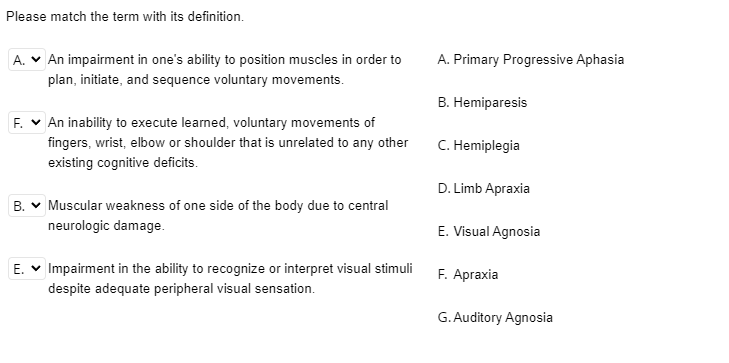Reading Quiz 4
Screening instruments in aphasia assessment may be useful in all of the following conditions except:
- ~~A clinician needs to establish appropriate recommendations for alternative-augmentative communication methods for hospital staff.~~
- A clinician needs to identify the aphasia-sub-type
Assessments that fall within the Participation level of the ICF for persons with aphasia includes:
| B. | ~~Reading Comprehension Battery for Aphasia - 2~~ | |
|---|---|---|
| C. | Semi-structured interview with family informant designed to assess patient's typical weekly and daily routines across settings. |
Unlike acute aphasia onset, Primary Progressive Aphasia…
- ~~is isolated to deficits in verbal expression~~
- gets worse across time.
"The cat was carried to the bed by the boy."
- Non-canonical
Strategies that clinicians might employ when assessing an individual's lexical retrieval system include the following:
- all of these
Bilingualism can be conceptualized as existing on a continuum with variations in a person's ability to use either language depending on task, modality, and amount of exposure to that language.
- TRUE
Confrontation naming describes the ability to verbalize (or write) the name for visually presented stimuli (e.g., objects, pictures).
- TRUE
Confrontation naming is a good predictor of communication in functional daily activities.
- ~~True~~
- FALSE
After an asessment, clinicians should be able to summarize the nature and severity of a person's language impairment, activity limitations, and societal participation.
- true
Please describe: 1. a task for assessing verbal expression that is unstructured, 2. a task for assessing verbal expression that is highly structured.
An unstructured conversation can be used to assess verbal expression. This way, the clinician and the client can use any modes of modality that would be best for them to continue the conversation.
A structured way of asses verbal expression could be the WAB. The WAB tests a person's spontaneous speech, repetition, and word-finding skills.
As part of the process approach, a clinician may administer standardized testing.
- True
A drawback of standardized testing is that individuals with different language profiles and abilities may score the same on subtests.
- True
Why does clinician write ALL behaviors and responses as part of the process approach? (Select multiple responses.)
To guide the rehabilitation plan.

F D B E
| \n An impairment in one's ability to position muscles in order to plan, initiate, and sequence voluntary movements. → Apraxia | |
|---|---|
| An inability to execute learned, voluntary movements of fingers, wrist, elbow or shoulder that is unrelated to any other existing cognitive deficits. → Limb Apraxia | |
| Muscular weakness of one side of the body due to central neurologic damage. → Hemiparesis | |
| \n Impairment in the ability to recognize or interpret visual stimuli despite adequate peripheral visual sensation. → Visual Agnosia |
